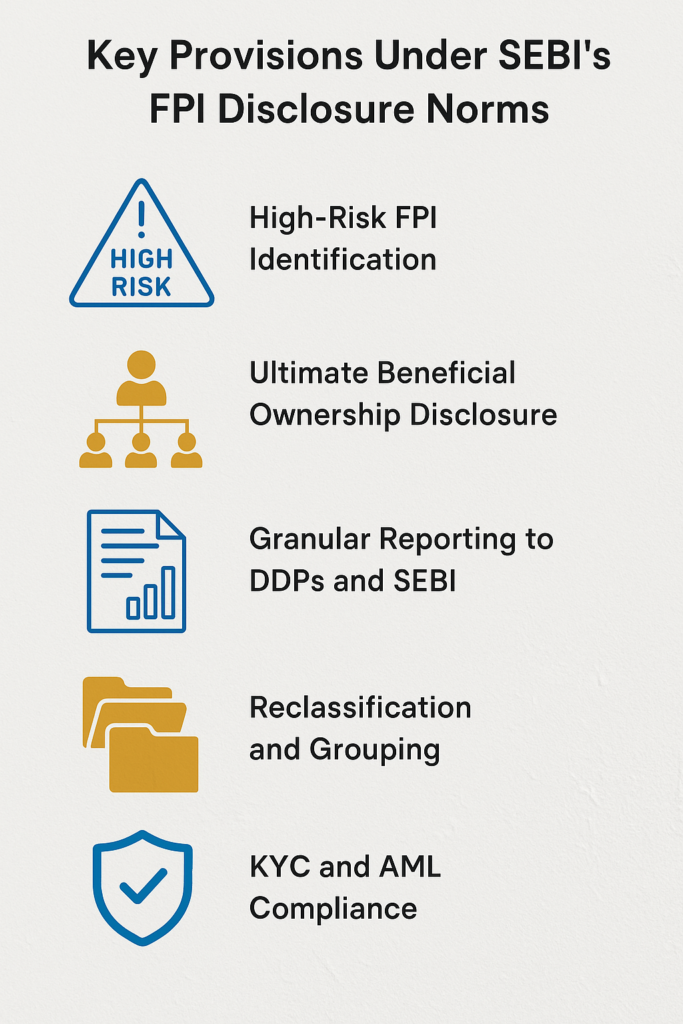
Introduction
The Securities and Exchange Board of India (SEBI) plays a crucial role in regulating foreign investments in the Indian securities market. With the growing participation of Foreign Portfolio Investors (FPIs), ensuring transparency and preventing misuse of foreign investments has become imperative. To address concerns around opacity and potential market manipulation, SEBI introduced revised FPI disclosure norms.
What is an FPI (Foreign Portfolio Investor)?
Foreign Portfolio Investors (FPIs) are entities registered with SEBI that invest in Indian financial assets such as equities, debt instruments, and derivatives.
Key Features:
- They are non-residents.
- They invest passively through listed securities.
- Must register under SEBI’s FPI Regulations, 2019.
Historical Background
- The evolution of SEBI’s FPI disclosure norms traces back to 2014, when the regulator replaced the earlier FII and QFI regimes with a more streamlined Foreign Portfolio Investor (FPI) framework.
- Over time, concerns arose regarding opacity in ownership structures and potential misuse of FPI routes, especially with the increasing use of tax havens.
- These concerns gained momentum around 2018, prompting SEBI to revisit its approach. In 2019, SEBI revamped the FPI regulations, enhancing transparency and risk-based categorization.
- Following the Adani-Hindenburg episode in 2023, SEBI introduced even more stringent disclosure requirements to track ultimate beneficial ownership and prevent market manipulation.
| Year | Development |
|---|---|
| 2014 | SEBI notified FPI Regulations for the first time, replacing FII norms. |
| 2018 | Concerns over beneficial ownership disclosures raised by industry. |
| 2019 | SEBI notified new FPI Regulations with reclassification of categories. |
| 2023 | Enhanced norms introduced after Adani-Hindenburg row for greater scrutiny. |
Objectives of SEBI’s FPI Disclosure Norms
- Enhance Transparency:
- To ensure clear visibility into the ownership structures of foreign investors in Indian markets.
- Identify Ultimate Beneficial Owners (UBOs):
- To trace the natural persons who actually control or benefit from FPI investments.
- Prevent Regulatory Circumvention:
- To stop investors from using layered or indirect routes to bypass investment caps and regulations.
- Strengthen Market Integrity:
- To safeguard Indian financial markets from manipulation, insider trading, and undue influence by anonymous foreign entities.
- Align with Global Standards:
- To bring India’s disclosure norms in line with international best practices and FATF (Financial Action Task Force) recommendations.
- Improve Monitoring and Surveillance:
- To enable SEBI and other regulators to better monitor inflows and flag suspicious or high-risk investments.
The primary goals of the revised norms are:
| Objective | Description |
|---|---|
| Transparency | To enhance visibility around the ownership structure of FPIs. |
| Prevent Circumvention | To ensure FPIs aren’t used to bypass Indian investment limits. |
| Data Integrity | To strengthen data reporting and monitoring mechanisms. |
| Ultimate Beneficial Ownership | To trace the actual owners behind large investments. |
| Harmonization | Align with global Anti-Money Laundering (AML) and FATF standards. |
Key Provisions Under SEBI’s FPI Disclosure Norms

1. High-Risk FPI Identification
SEBI now mandates additional disclosures from certain “high-risk” FPIs based on:
- Concentration of holdings (e.g., if an FPI holds more than 50% in a single group).
- Opaque ownership structures.
- Use of layered vehicles or tax-haven jurisdictions.
2. Ultimate Beneficial Ownership (UBO) Disclosure
FPIs must reveal natural persons holding ultimate control or ownership, especially when:
- Ownership exceeds 10%.
- The structure is opaque or involves multiple layers.
- The jurisdiction of incorporation lacks strong AML standards.
3. Granular Reporting to DDPs and SEBI
- FPIs must submit structured ownership data in prescribed formats.
- Reporting to Designated Depository Participants (DDPs) must be prompt.
- Any material change in structure/ownership must be reported within 7 working days.
4. Reclassification and Grouping
- SEBI requires grouping of FPIs under the same beneficial owner for investment cap monitoring.
- FPI investments are monitored on a group basis, not individually.
5. KYC and AML Compliance
- FPIs must comply with Know Your Customer (KYC) norms and Anti-Money Laundering (AML) standards as per FATF guidelines.
Safeguards and Carve-outs
SEBI has provided relaxations to ensure ease of business while maintaining compliance:
| Type of Investor | Disclosure Requirement |
|---|---|
| Government Entities | Exempted from UBO disclosures |
| Sovereign Wealth Funds (SWFs) | Partial exemption under specific cases |
| Pension Funds | Carve-out available |
| Exchange Traded Funds (ETFs) | Relaxed norms for diversified holdings |
| Public Retail Funds | Lesser stringency in UBO norms |
Old vs New Disclosure Norms
| Aspect | Earlier Norms (Pre-2023) | Revised Norms (Post-2023) |
|---|---|---|
| UBO Threshold | 25% in most cases | 10% or more |
| Grouping Based on Ownership | Not enforced strictly | Mandatory |
| KYC Requirements | Basic KYC | Enhanced, FATF-aligned KYC |
| Reporting Timeline | Flexible reporting | Strict deadlines and continuous updates |
| SWFs/Gov Funds Exemption | General exemptions | Refined exemptions based on classification |
| Tax Haven Jurisdictions | Lesser scrutiny | More stringent checks |
Global Comparison
| Country | UBO Disclosure Threshold | FPI Classification | AML Framework |
|---|---|---|---|
| India 🇮🇳 | 10% | Category I & II | FATF-aligned |
| USA 🇺🇸 | 25% | Institutional/Non-Institutional | SEC regulated |
| UK 🇬🇧 | 25% | FCA classification | Strong AML/KYC |
| Singapore 🇸🇬 | 25% | MAS regulations | FATF compliant |
Impact on Investors and Markets
Positive Outcomes:
- Improved investor confidence due to transparency.
- Enhanced market integrity.
- Better tracking of systemic risks.
Challenges:
- Increased compliance burden on FPIs.
- Potential exit of some FPIs from high-compliance jurisdictions.
- Concerns from small fund managers about disclosure thresholds.
Recent Updates (2024–2025)
- SEBI created a framework for high-risk jurisdiction monitoring.
- Coordination with RBI and Income Tax Department for sharing data.
- Technology adoption for automated verification of UBO disclosures.
Compliance Mechanism
Steps for FPIs:
- Register/renew with SEBI under appropriate category.
- Submit KYC and UBO information to DDPs.
- Use LEI (Legal Entity Identifier) for verification.
- Update SEBI/DDPs for any changes within 7 days.
- Participate in SEBI’s surveillance mechanisms.
Conclusion
SEBI’s FPI Disclosure Norms are a vital step toward creating a transparent, stable, and accountable financial market in India. By enforcing robust ownership disclosure requirements, SEBI ensures that foreign capital is aligned with ethical investment practices and national interest.
While the compliance requirements may seem rigorous, they are necessary for long-term market health, curbing money laundering, and ensuring that foreign entities operate within India’s legal and regulatory framework.
FAQs
Q1. What is the UBO threshold for FPI disclosures in India?
A: The threshold is 10% ownership for natural persons.
Q2. Are all FPIs required to disclose UBO details?
A: No, exemptions apply to government-related entities, public funds, SWFs, etc.
Q3. What happens if an FPI fails to disclose?
A: SEBI may suspend registration, impose penalties, or restrict investments.
Q4. How does SEBI monitor compliance?
A: Through DDPs, direct audits, and coordination with other regulators like RBI, IT Dept.















